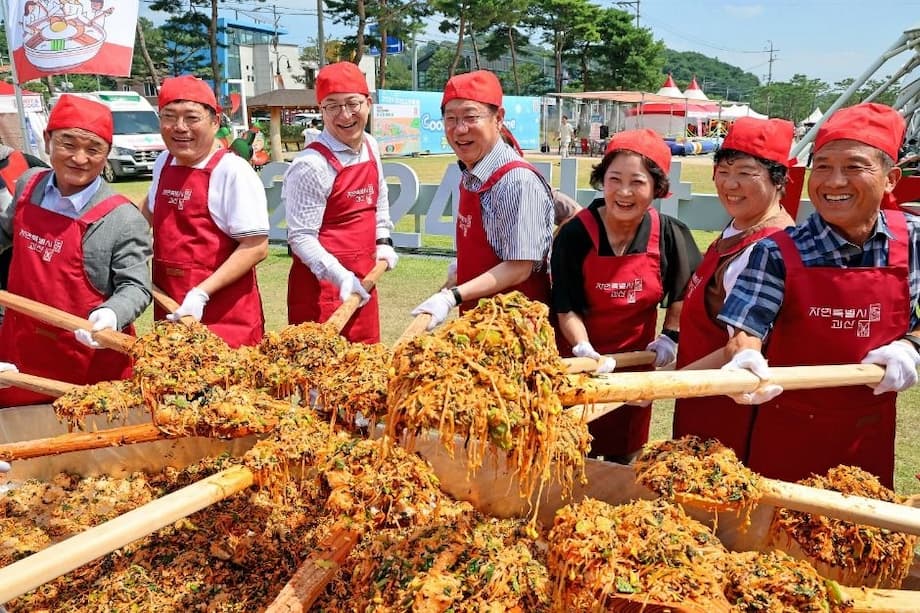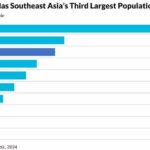Autumn in Korea 2025 brings food, light, and heritage
From mountain trails blushing with maple and ginkgo to seaside towns serving fresh shrimp, autumn in Korea is an open invitation to be outdoors. Mild days, cool evenings, and blue skies set the stage for a festival season that stretches from village greens to royal palaces. This year brings a rich mix of harvest celebrations, lantern and light displays, folk performances, and big city culture that are easy to pair with foliage trips to national parks and historic towns.
- Autumn in Korea 2025 brings food, light, and heritage
- Food and harvest festivals worth a trip
- Lights, art, and night experiences
- Heritage and tradition take center stage
- Cinema, music, beer, and urban culture
- Unique one night spectacles and regional time travel
- Planning around Chuseok and the October holidays
- Foliage, weather, and travel tips
- Key Points
Travel demand is already climbing. A rare cluster of public holidays in early October could become a 10 day break if the government adds a temporary holiday on Oct 10, which would combine National Foundation Day, the Chuseok harvest holiday, a substitute day, and Hangeul Day. Airlines have announced additional flights and fares are rising on popular routes, while hotels in major domestic destinations report heavy bookings for the early October week. Planning early for transport, lodging, and festival tickets can save time and money.
The guide below spotlights festivals confirmed for this fall, along with trusted annual events that typically run in October. Where dates vary each year, verify schedules close to your travel date on official pages or the national festival calendar.
Food and harvest festivals worth a trip
Autumn is peak season for regional flavors. Markets overflow with peppers, shrimp, persimmons, jujube, and chestnuts. Many festivals build hands on experiences into the program, so you get to taste, play, and learn alongside local families. Traditional snacks like jeon pancakes with a cup of makgeolli rice wine are perfect for cool evenings.
Goesan Red Pepper Festival (North Chungcheong)
Goesan County celebrates its signature organic clean red peppers and local farming culture with a lively program that mixes games, tastings, and music. Expect crowd favorites such as Find the Golden Pepper, Pepper Nanta percussion fun, and Catch the Pepper Fish. A giant red pepper bibimbap tasting draws long lines, while concerts and a youth festival keep the energy high. Pepper auctions, local markets, and tasting booths reward curious eaters, and the World Pepper Exhibition, pepper contests, and street busking round out the day. Bring cash for small purchases from farmers, and arrive early for the tastings.
Hongseong Namdang Port Shrimp Festival (South Chungcheong, through Oct 20)
Namdang Port is famed across Korea for its autumn shrimp. The star here is daeha, a giant shrimp known for clean, rich flavor. Visitors can try bare handed shrimp catching and go head to head in peeling contests, then listen to live music as the harbor glows at sunset. A busy night market and water fountain shows add to the atmosphere. Seafood vendors sell fresh catches by the kilo for grilling at nearby stalls or taking home on ice. If you want the best views, arrive before golden hour to secure a spot along the pier.
Practical tip: Fresh seafood is sold quickly. Bring a small insulated bag if you plan to take shrimp home. Card payments are common at larger stalls, but small vendors may prefer cash.
Yangpyeong Catfish Whiskers Festival (Gyeonggi, through Sep 7)
Set in the village of Sumimaru in Yangpyeong, this family friendly event capitalizes on clean rivers and rural charm that has won national recognition. Visitors can try catfish fishing, fruit syrup making, and short rides on all terrain vehicles. There are bubble play zones for children, picnic areas for families, and hearty countryside meals such as spicy fish stew. Admission ranges from 19,000 won to 49,000 won based on activity packages. It is an easy countryside day trip from Seoul, and a good way to introduce kids to river ecology and farm life.
Gangneung Coffee Festival and other regional tastes
October is coffee season on Korea’s east coast, and Gangneung usually hosts a caffeinated showcase of local roasters, barista competitions, and tasting classes. Elsewhere, regional events like the Gimje Horizon Festival in North Jeolla or the Bupyeong Pungmul Festival in Incheon bring folk music, markets, and seasonal foods to city squares. Dates can vary by year, so confirm schedules as your travel date approaches.
Lights, art, and night experiences
As nights grow longer, light events and evening openings turn gardens and parks into glowing stages. These are perfect pairings with dinner plans, and many are easy to reach by public transport.
Cheongdo Provence Light Festival (North Gyeongsang, through Nov 30)
A French inspired village in Cheongdo transforms after dusk with a sparkling light display and more than 100 photo zones. By day, quaint houses and pastel facades evoke the charm of southeastern France linked to artists like Van Gogh and Matisse. After dark, the village becomes a walkway of luminous arches and themed corners popular with couples and families. Weeknights are quieter than weekends, and tripods are permitted in many areas for long exposure shots.
Sejong National Arboretum night opening (through Oct 11)
One of the season’s most romantic strolls, Sejong National Arboretum opens selected zones at night for a limited run. Enhanced lighting now accents the Four Seasons Greenhouse, Festival Plaza, and the Korean Traditional Garden. Weekend programs each Saturday at 7:30 p.m. include orchestra performances, traditional music showcases, an open air cinema, and immersive story based shows. Admission is 2,500 won for adults, 2,000 won for teens, and 1,500 won for children. Bookings can sell out on clear nights, so consider weekday visits for a calmer experience.
Seoul light and drone shows also return in the second half of the year, including Hangang river light programs and seasonal media art nights. Parks like Haneul Sky Park host the Silver Grass Festival as plumes sway in the autumn breeze, and pink muhly fields become popular photo spots in suburban gardens and theme parks. Many are free or lightly ticketed, which makes them easy to add after a day of museum visits or markets.
Heritage and tradition take center stage
Autumn coincides with Korea’s biggest cultural calendar, when royal palaces, folk villages, and historic towns showcase living traditions. Expect a mix of daytime ceremonies and special evenings that reveal familiar landmarks in a new light.
K Royal Culture Festival (Seoul palaces, Oct 8 to Oct 12)
Seoul’s four main palaces and the UNESCO listed Jongmyo Shrine host Korea’s largest heritage festival each spring and autumn. The 2025 autumn edition expands programs for foreign visitors with multilingual support and easy reservations via a global platform. Highlights include the Gyeongbokgung Palace Hanbok Banquet where guests can wear traditional attire, enjoy dance performances, watch demonstrations by master artisans, shop a second hand hanbok pop up, sample traditional desserts, and join accessory workshops. Early birds can book the Awakening the Morning Palace program at Changdeokgung to explore the Secret Garden with cultural interpreters before public opening. A fusion concert, Ballet x Sujecheon, is set for Jibokjae Hall at Gyeongbokgung, blending court music with dance in a serene courtyard setting.
Families will find kid friendly royal court games and humanities talks at Deoksugung, while Changgyeonggung plans a Joseon Night event and playful time travel exhibits that bring palace daily life to the present. At Jongmyo Shrine, architecture tours and court music performances reveal a solemn side of royal ritual spaces. Foreign language reservations for Oct 8 to Oct 12 are supported online, with priority to prebooked visitors. For program specifics and booking instructions, see the latest notice from the Korea Heritage Service or media updates such as The Korea Herald’s festival page here.
Andong Mask Dance Festival and Jinju Lantern Festival
Two of Korea’s best known October traditions typically return with weeklong schedules. In Andong, master performers lead talchum mask dances, street parades, and workshops, and nearby Hahoe Folk Village (UNESCO) sets the scene for heritage tours. Down south in Jinju, thousands of lanterns illuminate the Namgang River, with wish lanterns drifting on the water after nightfall. Both cities are easy to combine with foliage trips, especially to nearby national parks and historic temples.
Anseong Namsadang Baudeogi Festival (Oct 9 to Oct 12)
Anseong in Gyeonggi celebrates namsadang nori, a dynamic folk performance tradition led by itinerant troupes. The festival has recognition from a UNESCO partner body and features tightrope acrobatics, drum and dance, reenacted ceremonies, and colorful parades. In 2025, global supporters from several countries joined preview activities to help share the story of Baudeogi, a historic star performer whose artistry opened the stage to women during the Joseon era. Performances run at Anseongmatchum Land and along Anseongcheon stream, with food stalls and hands on workshops throughout the grounds.
Cinema, music, beer, and urban culture
Coastal cities and Seoul neighborhoods fill weekends with film, music, and food culture. In Busan, the International Film Festival anchors the early October calendar with premieres, outdoor screenings, and fan events around Haeundae. Seoul plays host to seasonal fireworks, jazz in parks, and district events that showcase arts and crafts.
Jongno’s long running art fair returns to Insa dong and the Insa Central Museum with demonstrations by calligraphers and painters, plus hands on activities and guided tours. The following week turns the area into a tea and craft fair featuring traditional teas, wares, and regional craft makers, then an antique market with instruments, ceramics, furniture, and rare finds. In southern Seoul, Gwanak hosts a community open air cinema night at Gwanaksan Park, with family seating and snacks, while Gangbuk offers wellness themed afternoons with yoga, meditation, and small crafts on a forest stage. These district programs are free with online registration and add a local flavor to a city trip.
Autumn beer festivals are bubbling up across the capital as well, pairing craft brews with street food in historic markets and riverfront spaces. Neighborhood events make it easy to mingle after sunset without long travel times, and many align with wider city programs like light shows along the Han River.
Unique one night spectacles and regional time travel
For something different, plan around a single evening event that tells a centuries old story in a fresh way. On Oct 16, 2025, Gyeongsangnam do is set to host the Haman Nakhwa Nori, a historic ritual sometimes called the Falling Flower Fireworks Festival. Rather than explosive aerial fireworks, performers suspend small packets filled with oak charcoal powder above the water and ignite them with long torches from boats. The glowing embers fall like flower petals, filling the river with a soft, cascading light first recorded in the Joseon era and revived in recent decades. In 2008, the tradition was recognized as an Intangible Cultural Heritage of the province. The 2025 program also marks 60 years of Japan Korea diplomatic ties, with cultural exchange activities, hanbok fittings, folk music, and simple crafts. The best vantage points are around Mujinjeong Pavilion, where families gather well before dusk.
Gwangju Chungjang Festival
For four days in October, central Gwangju travels back in time. Streets transform into the 70s, 80s, and 90s with retro fashion, music, and a massive citizens parade. Food stalls serve nostalgic snacks and photo zones recreate old school storefronts. It is a playful way to understand how modern culture grew out of recent decades, and a reminder that Korean festivals can be as much about memory as they are about performance.
Planning around Chuseok and the October holidays
Chuseok is Korea’s mid autumn harvest celebration and a three day family holiday based on the lunar calendar. Many people travel to ancestral hometowns for memorial rites and meals featuring seasonal foods such as songpyeon rice cakes, jeon pancakes, and early rice wines. Traffic on expressways and trains is heavy, and some city restaurants close for family time. Museums and palaces often run special cultural programs, while convenience stores, large supermarkets, and many chain cafes stay open. If your trip overlaps Chuseok, plan for fuller trains, earlier sold out accommodations, and a city that feels both quiet in business districts and festive in heritage venues.
An extended holiday stretch in October 2025 has already sparked a travel rush. Travel agencies report strong demand for overseas routes, and airlines have announced extra flights, particularly to Japan and Southeast Asia. Round trip airfares on some routes are higher than earlier in the year, and domestic hotel bookings are tight for holiday days in early October. If your schedule is fixed, book early and pick flexibility where possible, such as refundable rates or trains outside peak hours. If you are flexible, consider shifting travel to late October when crowds thin and foliage improves in the mountains.
To monitor festival dates across the country, the national calendar maintained by Korea Tourism is a useful reference. Check listings by month and region, and recheck details a few days before travel since outdoor programs are sometimes adjusted for weather. You can browse the official listings here.
Foliage, weather, and travel tips
Weather in October is comfortable for full days outdoors. Expect daytime highs around 15 to 25 C, with cooler nights near 5 to 15 C. Air quality is generally good and humidity is low, but evenings can feel chilly, especially near the water or at elevation. Pack layers, including a light jacket or cardigan, and wear comfortable shoes for walking tours and palace grounds. A small umbrella or packable raincoat is useful for brief showers.
Where to see peak color
For classic foliage, Seoraksan and Naejangsan National Parks offer cliffside trails and temple valleys. Gyeongju presents a citywide history walk gilded in yellow and red, especially around Bomun Lake and ancient tomb parks. In the capital region, Asan Gingko Tree Road becomes a tunnel of gold, while Haneul Sky Park in western Seoul turns silver as grasses sway in the wind. Many of these spots pair naturally with nearby festivals, so you can plan a morning hike followed by a night market or light show.
Practical tips
- Reserve intercity trains and long distance buses early if traveling around the early October holidays.
- For palace programs and light festivals, weeknights are calmer than weekends.
- Carry a small reusable tumbler for coffee or makgeolli tastings where allowed, and cash for small market buys.
- Check accessibility details on event pages. Some night gardens have stroller friendly routes, while others include stairs.
- For shrimp and seafood events, bring an insulated bag if you plan to purchase fresh items.
Key Points
- Harvest food events headline the season, including Goesan Red Pepper and Hongseong’s shrimp festival (through Oct 20).
- Night attractions include Cheongdo Provence Light Festival (through Nov 30) and Sejong National Arboretum’s evening opening (through Oct 11).
- K Royal Culture Festival runs Oct 8 to Oct 12 across Seoul’s palaces and Jongmyo Shrine with expanded multilingual programs.
- Signature October traditions like Jinju Lantern and the Andong Mask Dance Festival return as regional cultural anchors.
- Anseong’s Namsadang Baudeogi Festival showcases tightrope and folk performance from Oct 9 to Oct 12.
- Haman Nakhwa Nori presents a historic falling ember ritual on Oct 16 near Mujinjeong Pavilion.
- Seoul districts offer community events, from Insa dong art and tea fairs to open air cinema and wellness programs.
- Travel may surge around a potential 10 day holiday stretch in early October, so book transport and lodging early.
- October weather favors outdoor plans, with highs around 15 to 25 C and cool nights, perfect for hikes and night markets.
- Verify dates on the national festival calendar shortly before travel, since outdoor programs can shift with weather.




